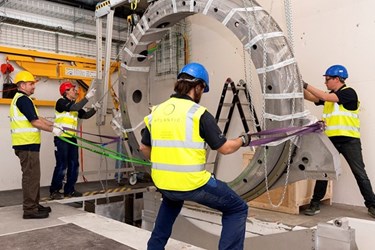Philips, Elekta Build MR-guided Linear Accelerator In The Netherlands

The National Cancer Institute (NKI) has begun construction on a high-field MR-guided linear accelerator (MR-linac) system, making it the third member of the Elekta MR-linac Consortium to do so since Elekta partnered with Philips in 2012. The MR-linac system, which combines MRI with radiation delivery, allows oncologists to better target difficult cancers and reduce the amount of radiation used in cancer therapies.
In 2012, Elekta and Philips built a prototype MR-linac system at the University Medical Center Utrecht (UMCU), combining Elekta’s expertise in neurosurgery and radiation systems with Philips’ MRI imaging technology. To further test and develop the MR-linac, the companies co-founded a consortium of top cancer centers worldwide, where they would install the systems for research purposes.
“Bringing the superior soft tissue imaging of MRI and precise radiotherapy together in one device could potentially revolutionize cancer care,” said Tomas Puusepp, president and CEO of Elekta, in a 2012 press release, explaining that the system allows doctors to maximize the dosage of radiation in cancerous cells, while avoiding the surrounding healthy tissues and reducing the total amount of radiation used.
So far, the system has been installed at UMCU and the University of Texas MD Anderson Cancer Center in Houston, with NKI housing the third installation. By the end of 2016, Elekta plans to begin the installation process at all seven of the consortium member locations, which are currently evaluating data from the existing systems and establishing clinical research protocols. At this time, the system is not commercially available.
Uulke van der Heide, medical physicist at The NKI, said in a recent press release that the MR-linac system is the next step in the “obvious evolution” of radiation therapy, adding that the technology will allow his colleagues to adjust and direct radiation doses in real time, and has the potential to “reduce the global burden of cancer.”
Puusepp noted that the MR-linac system is not Elekta’s first collaboration with The NKI, which played a critical role in the development of cone beam CT imaging technology.
“Elekta has a long heritage of strategic collaborations with leading cancer researchers and practitioners,” said Puusepp. “We rely on these relationships to help validate our technologies and to enable us to continually improve upon them.”
According to Rob Cascella, CEO of Philips Imaging Businesses, MRI is fast becoming an invaluable tool in oncology, allowing doctors to better plan, guide, and assess radiation therapy. “The clinical effectiveness of radiation treatment depends highly on the quality and accuracy of radiotherapy guidance and delivery,” said Cascella in a statement.
Since Philips split its company in two parts — lighting and health tech — the company has been sizing up M&A opportunities, particularly in radiotherapy, imaging, and home care. Bloomberg singled out Elekta as a possible acquisition target for Philips last August, noting the existing partnership.
“Elekta would be a really good fit for Philips and the two companies know each other well as they already have a project in common,” said Johan Unnerus, an analyst at Swedbank AB in Stockholm, to Bloomberg.
